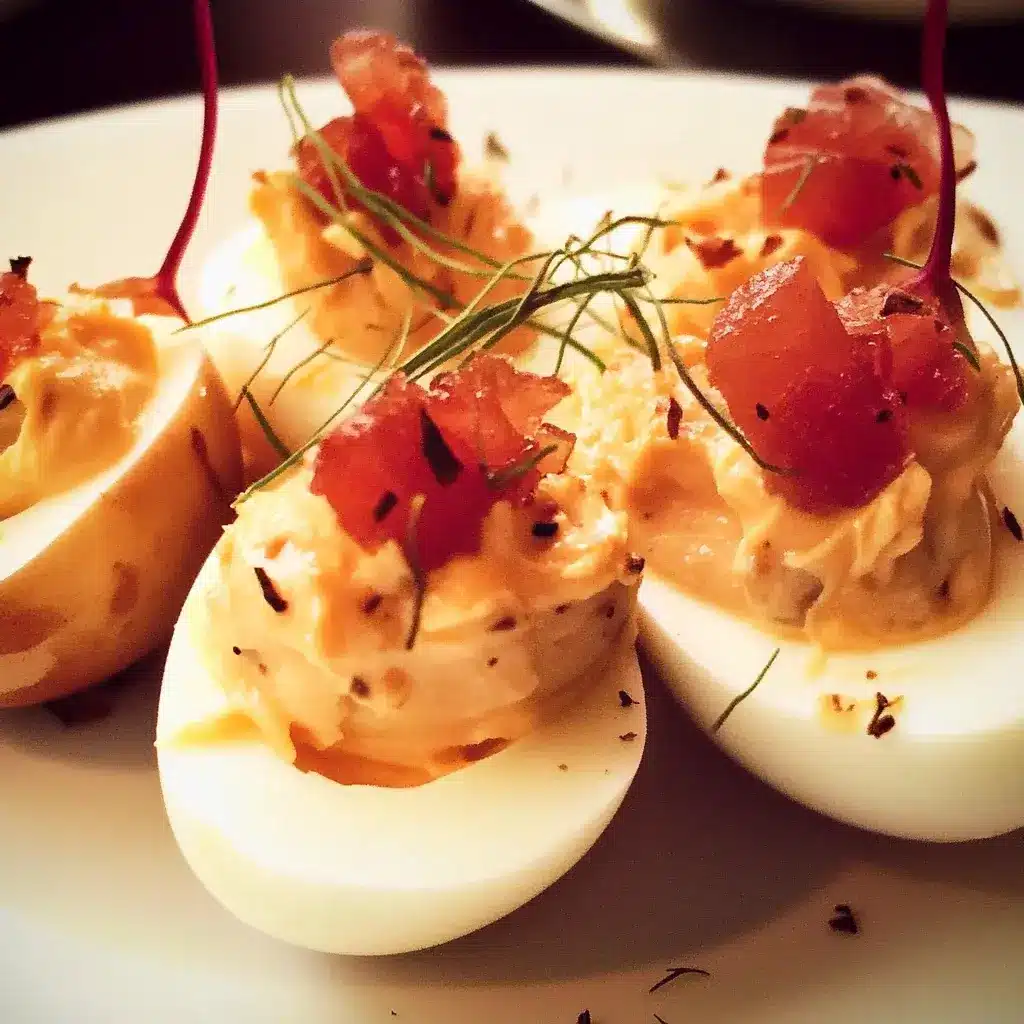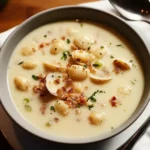I still remember the first time I decided to jazz up the classic deviled egg for a family gathering. Standard deviled eggs are always a hit, but I wanted something a little more sophisticated, something that would really make people pause and say “Wow!” I landed on the idea of incorporating smoked salmon – its rich, smoky flavor and luxurious texture seemed like a perfect match for the creamy, tangy yolk filling. To say they were a success would be an understatement. My notoriously picky nephew, who usually eyes anything “fancy” with suspicion, devoured three before anyone else could get near the platter. My sister immediately asked for the recipe, and they’ve since become my signature appetizer for holidays, brunches, and any occasion that calls for something a little special. These Salmon Deviled Eggs aren’t just food; they’re conversation starters, memory makers, and proof that elevating a classic can lead to delicious discoveries. The combination of perfectly cooked eggs, creamy, savory salmon filling, and the bright pop of fresh dill is simply irresistible. They look elegant, taste divine, and are surprisingly straightforward to make. Trust me, once you try this version, you might never go back to plain deviled eggs again!
Ingredients for The Ultimate Salmon Deviled Eggs
Crafting these delectable bites requires a balance of quality ingredients. The star, of course, is the salmon, but the supporting cast plays a crucial role in creating the perfect creamy texture and layered flavor profile. Precision in measurement ensures consistency, but feel free to adjust seasoning slightly to your personal preference.
- Large Eggs: 6 (Using large eggs provides a good size for filling and presentation. Ensure they are fresh for easier peeling.)
- Good Quality Smoked Salmon: 4 ounces (finely minced. Opt for cold-smoked salmon, often labeled as lox-style, for its silky texture and less intense smokiness compared to hot-smoked. Ensure it’s finely minced for a smooth filling.)
- Mayonnaise: 1/4 cup (Use full-fat mayonnaise for the best flavor and creamy consistency. Brands like Duke’s or Hellmann’s/Best Foods are popular choices.)
- Dijon Mustard: 1 teaspoon (Adds a tangy complexity that cuts through the richness. Grainy or smooth Dijon works, depending on your texture preference.)
- Fresh Lemon Juice: 1 teaspoon (Brightens the flavors and complements the salmon beautifully. Always use fresh juice, not bottled.)
- Fresh Dill: 1 tablespoon (finely chopped, plus extra sprigs for garnish. Dill and salmon are a classic pairing for a reason; its fresh, slightly anise-like flavor is essential.)
- Capers: 1 tablespoon (rinsed and finely chopped, optional but recommended. They add a delightful briny pop that contrasts well with the richness.)
- Salt: 1/4 teaspoon (or to taste. Remember that smoked salmon and capers are already salty, so start small.)
- Freshly Ground Black Pepper: 1/8 teaspoon (or to taste. Freshly ground offers superior flavor.)
- Paprika: For garnish (optional. Smoked paprika adds a subtle smoky echo, while sweet paprika adds color.)
- Red Onion or Shallot: 1 tablespoon (finely minced, optional. Adds a subtle pungent bite if desired.)
Step-by-Step Instructions: Crafting Your Salmon Deviled Eggs
Follow these instructions carefully to achieve perfectly creamy, flavorful, and beautifully presented Salmon Deviled Eggs. The process can be broken down into three main stages: preparing the eggs, creating the filling, and assembling the final appetizer.
Stage 1: Preparing the Perfect Hard-Boiled Eggs
The foundation of any great deviled egg is a perfectly cooked egg white shell and a fully cooked, bright yellow yolk. Overcooked eggs result in a rubbery white and a dreaded green ring around the yolk, while undercooked eggs will be difficult to work with.
- Place Eggs: Gently place the 6 large eggs in a single layer at the bottom of a medium saucepan. Avoid overcrowding the pan.
- Add Cold Water: Cover the eggs with cold water by at least 1 inch. Starting with cold water helps the eggs cook more evenly and can reduce cracking.
- Bring to a Boil: Place the saucepan over high heat and bring the water to a rolling boil.
- Cook: Once the water reaches a rolling boil, immediately cover the pan with a tight-fitting lid, remove the pan from the heat, and let it stand for 10-12 minutes (for large eggs). Do not lift the lid during this time. This residual heat method cooks the eggs gently and perfectly. Adjust timing slightly for different egg sizes (e.g., 9 minutes for medium, 15 minutes for extra-large).
- Prepare Ice Bath: While the eggs are standing, fill a medium bowl with ice cubes and cold water.
- Chill Eggs: As soon as the standing time is up, use a slotted spoon to carefully transfer the cooked eggs immediately into the ice bath. Let them chill completely, for at least 10-15 minutes. The ice bath serves two crucial purposes: it stops the cooking process instantly (preventing the green ring) and makes the eggs significantly easier to peel by causing the egg white to contract slightly from the shell.
- Peel Eggs: Once completely cooled, gently tap each egg on a hard surface to crack the shell all over. Roll it gently between your hands to loosen the shell further. Start peeling under cool running water or submerged in the ice bath – the water helps to get under the membrane and release the shell cleanly. Pat the peeled eggs dry with a paper towel.
Stage 2: Creating the Creamy Salmon Filling
This is where the magic happens. The combination of creamy yolk, savory salmon, and bright aromatics creates an unforgettable filling.
- Slice Eggs & Remove Yolks: Carefully slice each peeled egg in half lengthwise using a sharp knife. Wipe the blade clean between cuts for neat halves. Gently scoop out the cooked yolks and place them in a medium bowl. Arrange the egg white halves neatly on a serving platter or a tray lined with paper towels (to prevent slipping).
- Mash Yolks: Using a fork, mash the egg yolks thoroughly until they are fine and crumbly. Break up any large pieces to ensure a smooth final texture.
- Add Filling Ingredients: To the mashed yolks, add the mayonnaise, Dijon mustard, fresh lemon juice, finely chopped fresh dill, finely minced smoked salmon, and optional capers and minced red onion/shallot.
- Mix Thoroughly: Stir everything together gently but thoroughly until well combined and creamy. Be careful not to overmix, which can make the filling gummy, but ensure there are no large streaks of yolk or mayonnaise remaining.
- Season: Taste the mixture and season with salt and freshly ground black pepper as needed. Remember the salmon and capers contribute saltiness, so taste before adding too much salt. Adjust lemon juice or mustard if desired for extra tang. The filling should be flavorful and well-balanced.
Stage 3: Assembling and Garnishing Your Masterpieces
Presentation elevates these deviled eggs from tasty to truly impressive. Piping the filling creates a professional look, but spooning works too.
- Prepare for Filling: You have two options for filling the egg white halves:
- Piping (Recommended for elegance): Transfer the salmon-yolk mixture to a piping bag fitted with a star tip or a round tip. Alternatively, you can use a sturdy zip-top plastic bag – simply fill the bag, push the filling towards one corner, and snip off a small piece of the corner to create a makeshift piping bag.
- Spooning: Use two small spoons to carefully scoop and fill each egg white half. This method is simpler but may not look quite as neat.
- Fill the Egg Whites: Carefully pipe or spoon the salmon filling generously into the cavity of each egg white half. Aim for a visually appealing mound of filling.
- Garnish: This is the final touch that adds visual appeal and extra flavor. Sprinkle the filled eggs lightly with paprika (smoked or sweet). Top each deviled egg with a small sprig of fresh dill. Other optional garnishes include a whole caper, a tiny sliver of smoked salmon, a sprinkle of finely chopped chives, or even a few salmon roe (ikura) for a luxurious touch.
- Chill Before Serving: For the best flavor and texture, cover the assembled deviled eggs loosely with plastic wrap (you can insert toothpicks into a few eggs to prevent the wrap from smushing the filling) and refrigerate for at least 30 minutes before serving. This allows the flavors to meld and ensures they are nicely chilled.
Understanding the Nutrition: Salmon Deviled Eggs Facts
While deviled eggs are often seen as an indulgence, incorporating salmon adds significant nutritional benefits, particularly heart-healthy Omega-3 fatty acids. However, portion control is still key. Please note that these values are estimates and can vary based on specific ingredients used (e.g., type of mayonnaise, size of eggs, exact amount of salmon).
- Servings: This recipe makes 12 deviled egg halves.
- Serving Size: 1 deviled egg half.
- Estimated Calories Per Serving (1 half): Approximately 80-110 calories.
Key Nutritional Highlights (per serving estimate):
- Protein: Eggs and salmon make these a good source of high-quality protein, important for satiety and muscle maintenance. (Approx. 4-6g protein per half).
- Healthy Fats: Smoked salmon is rich in Omega-3 fatty acids (EPA and DHA), known for their benefits to heart health, brain function, and reducing inflammation. Eggs also contribute healthy fats, primarily found in the yolk.
- Vitamins and Minerals: Eggs are a source of Vitamin D, Vitamin B12, selenium, and choline. Salmon adds more B vitamins and Vitamin D.
- Considerations: The mayonnaise contributes saturated fat and calories. Using light mayonnaise can reduce fat and calories, but may slightly alter the texture and flavor. Sodium content can be relatively high due to smoked salmon, capers, and added salt – be mindful if monitoring sodium intake.
These Salmon Deviled Eggs offer a more nutrient-dense profile compared to traditional versions, making them a smarter yet still delicious appetizer choice.
Timing is Everything: Preparation Time Breakdown
Knowing how long a recipe takes helps with planning, especially when preparing for guests or an event. This breakdown includes active preparation time and passive chilling/cooking time.
- Preparation Time (Active): 20-25 minutes (This includes peeling eggs, mincing salmon/herbs, mixing the filling, and assembling the eggs).
- Cook Time (Passive – for eggs): 10-12 minutes (boiling/standing time for eggs).
- Chilling Time (Passive – initial egg cooling): 15 minutes (minimum time in ice bath).
- Chilling Time (Passive – final melding): 30 minutes (minimum time in the refrigerator before serving).
- Total Time: Approximately 1 hour 15 minutes to 1 hour 22 minutes (from starting the eggs to serving).
Note: You can multitask during passive times. While eggs are cooking or chilling, you can prepare the other filling ingredients (mince salmon, chop dill, measure mayo/mustard). This can slightly reduce the overall calendar time needed.
Serving Suggestions: Presenting Your Salmon Deviled Eggs with Flair
Presentation significantly impacts the dining experience. These Salmon Deviled Eggs are inherently elegant, but a few thoughtful touches can elevate them further. Here’s how to serve them for maximum impact:
- Platter Perfection:
- Choose an attractive serving platter. White or clear glass platters allow the colors of the eggs and garnish to pop. Slate or dark ceramic can provide a dramatic contrast.
- Consider a dedicated deviled egg platter with indentations to keep the eggs stable and prevent them from sliding around.
- Arrange the eggs neatly in a single layer. Avoid overcrowding the platter.
- Garnish Galore (Beyond Dill and Paprika):
- Capers: Place one whole rinsed caper on top of each egg for a defined briny burst.
- Salmon Roe (Ikura): For ultimate luxury, top each egg with a small cluster of glistening salmon roe. The pop of salty flavor is divine.
- Lemon Zest: A tiny grating of fresh lemon zest adds brightness and visual appeal.
- Finely Minced Chives: Offers a mild oniony flavor and delicate green color.
- Everything Bagel Seasoning: A sprinkle adds texture and a complex savory flavor that pairs surprisingly well.
- Microgreens: A few delicate microgreens add a touch of freshness and sophistication.
- Thin Radish Slices: A very thin slice of radish adds a peppery crunch and color contrast.
- Serving Contexts:
- Appetizer Spread: Serve alongside other finger foods like shrimp cocktail, cheese and crackers, or vegetable crudités with dip.
- Brunch Star: A perfect addition to a brunch menu, complementing dishes like quiche, fruit salad, and pastries.
- Holiday Gatherings: Ideal for Easter, Mother’s Day, Christmas, or New Year’s Eve parties. Their elegant appearance suits festive occasions.
- Cocktail Parties: Easy-to-eat finger food that pairs well with various drinks.
- Picnics and Potlucks: Transport them carefully in a deviled egg carrier or a well-sealed container, keeping them chilled.
- Creative Serving Vessels:
- For a more formal plated appetizer, serve two halves per person on a small plate, perhaps nestled on a bed of arugula or watercress.
- Use small, decorative spoons placed alongside the platter for easy self-serving.
- Pairing Power:
- Drinks: Crisp white wines like Sauvignon Blanc, Pinot Grigio, or Albariño complement the salmon and lemon. Sparkling wine or Champagne is always a festive choice. A dry Rosé also works well. For non-alcoholic options, consider sparkling water with lemon or cucumber, or iced tea.
- Food Accompaniments: Offer plain crackers, melba toasts, or cucumber slices alongside for those who want a crunchy base.
- Temperature is Key: Always serve these deviled eggs well-chilled. Remove them from the refrigerator just before serving. If they’ll be sitting out for an extended period (like at a buffet), place the serving platter on a larger tray filled with ice to keep them cool and safe.
Pro Tips for Perfect Salmon Deviled Eggs Every Time
Achieving deviled egg perfection consistently involves a few key techniques. Master these tips, and your Salmon Deviled Eggs will always be showstoppers.
- Master the Hard-Boiled Egg: This is foundational. Avoid the common pitfalls of overcooking (green ring, rubbery white) or undercooking (runny center). The cold water start, removing from heat once boiling, and immediate ice bath method described in the instructions is highly reliable. Another popular method is steaming: place eggs in a steamer basket over an inch of boiling water, cover, and steam for 12-14 minutes, followed by an ice bath. Older eggs (about a week old) tend to peel more easily than very fresh eggs.
- Achieve Ultra-Smooth Filling: For the creamiest, most luxurious filling texture, consider using a mini food processor or an immersion blender (in a suitable container) to blend the cooked yolks with the mayonnaise, mustard, and lemon juice before adding the minced salmon, dill, and capers. Mash the yolks first with a fork, then pulse them with the wet ingredients until perfectly smooth. Gently fold in the salmon and herbs afterwards by hand to maintain some texture from the salmon. Ensure your mayonnaise and yolks aren’t fridge-cold, as room temperature ingredients blend more smoothly.
- Piping for Presentation: While spooning the filling is functional, piping creates a much more elegant and professional look. Invest in a basic piping bag and a few tips (like a large star or round tip). If you don’t have one, a heavy-duty zip-top bag with the corner snipped off works surprisingly well. Practice your piping swirl on a plate first if you’re unsure. Fill the bag only about two-thirds full to avoid overflow and maintain control.
- Smart Make-Ahead Strategy: Deviled eggs are best enjoyed fresh, but you can prepare components ahead to save time, especially for parties. You can hard-boil, peel, and halve the eggs up to 2 days in advance. Store the cooked egg whites tightly covered in the refrigerator. Prepare the yolk filling (including the salmon and all other ingredients) up to 1 day ahead and store it in an airtight container or the prepared piping bag (with the tip sealed) in the refrigerator. Fill the eggs just before serving or up to a few hours ahead (chill immediately after filling). Garnish just before they hit the table for maximum freshness.
- Don’t Skimp on Quality Ingredients: The final product is only as good as its components. Use good quality, flavorful cold-smoked salmon – the difference is noticeable. Fresh dill is far superior to dried dill in this recipe. Use freshly squeezed lemon juice for brightness. Choose a mayonnaise you enjoy the taste of, as it forms the base of the filling’s creaminess. High-quality ingredients elevate this simple appetizer to something truly special.
Frequently Asked Questions About Salmon Deviled Eggs
Here are answers to some common questions about making and enjoying Salmon Deviled Eggs:
- Q: Can I make Salmon Deviled Eggs ahead of time?
- A: Yes, with caveats for optimal freshness. You can hard-boil and peel the eggs up to 2 days in advance, storing the whites covered in the fridge. The salmon-yolk filling can be prepared up to 1 day ahead and stored separately in an airtight container or piping bag in the fridge. For best results, assemble (fill and garnish) the deviled eggs no more than 4-6 hours before serving, keeping them chilled. If you must assemble them the day before, store them tightly covered in the fridge and be aware the texture might soften slightly, and the garnish (like dill) might wilt a bit. Garnish just before serving if possible.
- Q: What kind of salmon is best for this recipe?
- A: Cold-smoked salmon (often labeled as lox or Nova lox) is generally preferred for its silky texture and delicate smoky flavor, which blends beautifully into the creamy filling without overpowering it. Hot-smoked salmon (which is flaky like cooked salmon) can also be used, but it will result in a different, flakier texture and potentially a stronger smoky taste; ensure it’s finely flaked. Canned salmon can be used in a pinch if drained very well and flaked finely, but the flavor and texture will be significantly different from smoked salmon. High-quality, fresh, cooked salmon (like poached or baked leftovers), chilled and finely flaked, is another alternative if you don’t want a smoky flavor.
- Q: My deviled egg filling seems a bit runny. How can I fix it?
- A: Runny filling usually happens due to too much liquid (lemon juice, wet salmon) or not enough binder (yolk, mayo). First, ensure your smoked salmon wasn’t overly wet; pat it slightly dry if needed before mincing. To fix a slightly runny filling, you can try adding a tiny bit more mashed egg yolk (if you have an extra boiled egg) or a little more mayonnaise. Adding a very small amount of cream cheese (softened) can also help thicken it but will alter the flavor slightly. Start with small additions, mix well, and check the consistency. Chilling the filling for longer can also help it firm up.
- Q: How long do Salmon Deviled Eggs last in the refrigerator?
- A: Properly stored in an airtight container in the refrigerator, assembled Salmon Deviled Eggs should be consumed within 2 days for best quality and food safety. Due to the nature of eggs, mayonnaise, and fish, it’s crucial to keep them consistently chilled below 40°F (4°C) and avoid letting them sit at room temperature for more than 2 hours (or 1 hour if the ambient temperature is above 90°F/32°C). If they develop any off-smell or appearance, discard them.
- Q: Can I customize this recipe with other ingredients or substitutions?
- A: Absolutely! This recipe is a great base for customization.
- Herbs: Swap dill for fresh chives, parsley, or tarragon.
- Spice: Add a pinch of cayenne pepper or a dash of hot sauce (like Sriracha) for heat.
- Creaminess: Substitute some or all of the mayonnaise with Greek yogurt or sour cream for a tangier, lighter filling (texture will vary). Softened cream cheese (about 1-2 tablespoons) can add extra richness and stability.
- Flavor Boosters: Add a touch of prepared horseradish for a zesty kick, some finely chopped celery for crunch, or a pinch of Old Bay seasoning for a different flavor profile.
- Garnishes: Get creative with garnishes like crumbled bacon (surf and turf!), finely diced cucumber, or a sprinkle of toasted sesame seeds. Experiment and find your favorite combination!
- A: Absolutely! This recipe is a great base for customization.

Salmon Deviled Eggs recipe
Ingredients
-
- Large Eggs: 6 (Using large eggs provides a good size for filling and presentation. Ensure they are fresh for easier peeling.)
-
- Good Quality Smoked Salmon: 4 ounces (finely minced. Opt for cold-smoked salmon, often labeled as lox-style, for its silky texture and less intense smokiness compared to hot-smoked. Ensure it’s finely minced for a smooth filling.)
-
- Mayonnaise: 1/4 cup (Use full-fat mayonnaise for the best flavor and creamy consistency. Brands like Duke’s or Hellmann’s/Best Foods are popular choices.)
-
- Dijon Mustard: 1 teaspoon (Adds a tangy complexity that cuts through the richness. Grainy or smooth Dijon works, depending on your texture preference.)
-
- Fresh Lemon Juice: 1 teaspoon (Brightens the flavors and complements the salmon beautifully. Always use fresh juice, not bottled.)
-
- Fresh Dill: 1 tablespoon (finely chopped, plus extra sprigs for garnish. Dill and salmon are a classic pairing for a reason; its fresh, slightly anise-like flavor is essential.)
-
- Capers: 1 tablespoon (rinsed and finely chopped, optional but recommended. They add a delightful briny pop that contrasts well with the richness.)
-
- Salt: 1/4 teaspoon (or to taste. Remember that smoked salmon and capers are already salty, so start small.)
-
- Freshly Ground Black Pepper: 1/8 teaspoon (or to taste. Freshly ground offers superior flavor.)
-
- Paprika: For garnish (optional. Smoked paprika adds a subtle smoky echo, while sweet paprika adds color.)
-
- Red Onion or Shallot: 1 tablespoon (finely minced, optional. Adds a subtle pungent bite if desired.)
Instructions
Stage 1: Preparing the Perfect Hard-Boiled Eggs
The foundation of any great deviled egg is a perfectly cooked egg white shell and a fully cooked, bright yellow yolk. Overcooked eggs result in a rubbery white and a dreaded green ring around the yolk, while undercooked eggs will be difficult to work with.
-
- Place Eggs: Gently place the 6 large eggs in a single layer at the bottom of a medium saucepan. Avoid overcrowding the pan.
-
- Add Cold Water: Cover the eggs with cold water by at least 1 inch. Starting with cold water helps the eggs cook more evenly and can reduce cracking.
-
- Bring to a Boil: Place the saucepan over high heat and bring the water to a rolling boil.
-
- Cook: Once the water reaches a rolling boil, immediately cover the pan with a tight-fitting lid, remove the pan from the heat, and let it stand for 10-12 minutes (for large eggs). Do not lift the lid during this time. This residual heat method cooks the eggs gently and perfectly. Adjust timing slightly for different egg sizes (e.g., 9 minutes for medium, 15 minutes for extra-large).
-
- Prepare Ice Bath: While the eggs are standing, fill a medium bowl with ice cubes and cold water.
-
- Chill Eggs: As soon as the standing time is up, use a slotted spoon to carefully transfer the cooked eggs immediately into the ice bath. Let them chill completely, for at least 10-15 minutes. The ice bath serves two crucial purposes: it stops the cooking process instantly (preventing the green ring) and makes the eggs significantly easier to peel by causing the egg white to contract slightly from the shell.
-
- Peel Eggs: Once completely cooled, gently tap each egg on a hard surface to crack the shell all over. Roll it gently between your hands to loosen the shell further. Start peeling under cool running water or submerged in the ice bath – the water helps to get under the membrane and release the shell cleanly. Pat the peeled eggs dry with a paper towel.
Stage 2: Creating the Creamy Salmon Filling
This is where the magic happens. The combination of creamy yolk, savory salmon, and bright aromatics creates an unforgettable filling.
-
- Slice Eggs & Remove Yolks: Carefully slice each peeled egg in half lengthwise using a sharp knife. Wipe the blade clean between cuts for neat halves. Gently scoop out the cooked yolks and place them in a medium bowl. Arrange the egg white halves neatly on a serving platter or a tray lined with paper towels (to prevent slipping).
-
- Mash Yolks: Using a fork, mash the egg yolks thoroughly until they are fine and crumbly. Break up any large pieces to ensure a smooth final texture.
-
- Add Filling Ingredients: To the mashed yolks, add the mayonnaise, Dijon mustard, fresh lemon juice, finely chopped fresh dill, finely minced smoked salmon, and optional capers and minced red onion/shallot.
-
- Mix Thoroughly: Stir everything together gently but thoroughly until well combined and creamy. Be careful not to overmix, which can make the filling gummy, but ensure there are no large streaks of yolk or mayonnaise remaining.
-
- Season: Taste the mixture and season with salt and freshly ground black pepper as needed. Remember the salmon and capers contribute saltiness, so taste before adding too much salt. Adjust lemon juice or mustard if desired for extra tang. The filling should be flavorful and well-balanced.
Stage 3: Assembling and Garnishing Your Masterpieces
Presentation elevates these deviled eggs from tasty to truly impressive. Piping the filling creates a professional look, but spooning works too.
-
- Prepare for Filling: You have two options for filling the egg white halves:
-
- Piping (Recommended for elegance): Transfer the salmon-yolk mixture to a piping bag fitted with a star tip or a round tip. Alternatively, you can use a sturdy zip-top plastic bag – simply fill the bag, push the filling towards one corner, and snip off a small piece of the corner to create a makeshift piping bag.
-
- Spooning: Use two small spoons to carefully scoop and fill each egg white half. This method is simpler but may not look quite as neat.
-
- Prepare for Filling: You have two options for filling the egg white halves:
-
- Fill the Egg Whites: Carefully pipe or spoon the salmon filling generously into the cavity of each egg white half. Aim for a visually appealing mound of filling.
-
- Garnish: This is the final touch that adds visual appeal and extra flavor. Sprinkle the filled eggs lightly with paprika (smoked or sweet). Top each deviled egg with a small sprig of fresh dill. Other optional garnishes include a whole caper, a tiny sliver of smoked salmon, a sprinkle of finely chopped chives, or even a few salmon roe (ikura) for a luxurious touch.
-
- Chill Before Serving: For the best flavor and texture, cover the assembled deviled eggs loosely with plastic wrap (you can insert toothpicks into a few eggs to prevent the wrap from smushing the filling) and refrigerate for at least 30 minutes before serving. This allows the flavors to meld and ensures they are nicely chilled.
Nutrition
- Serving Size: one normal portion
- Calories: 80-110





